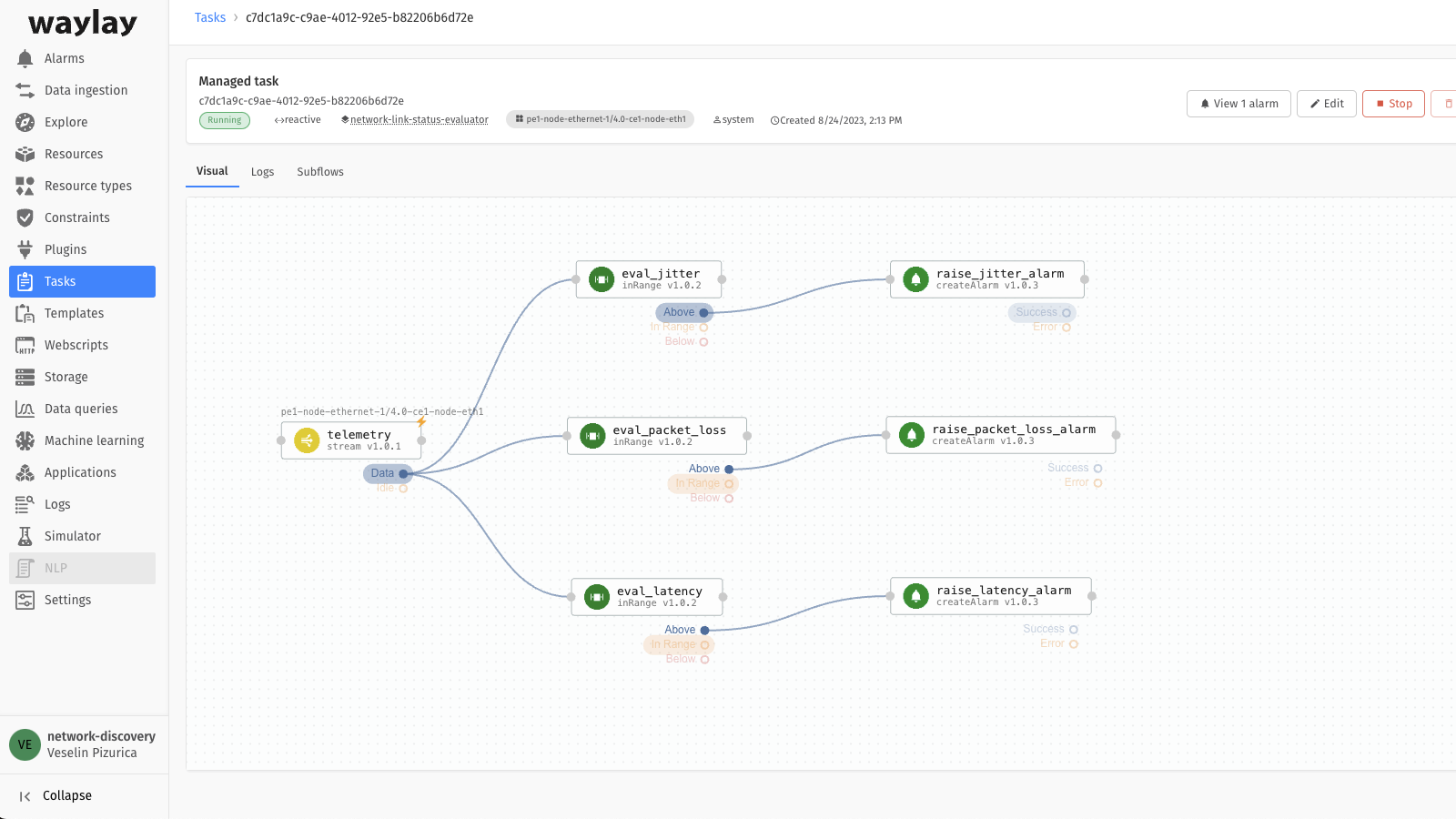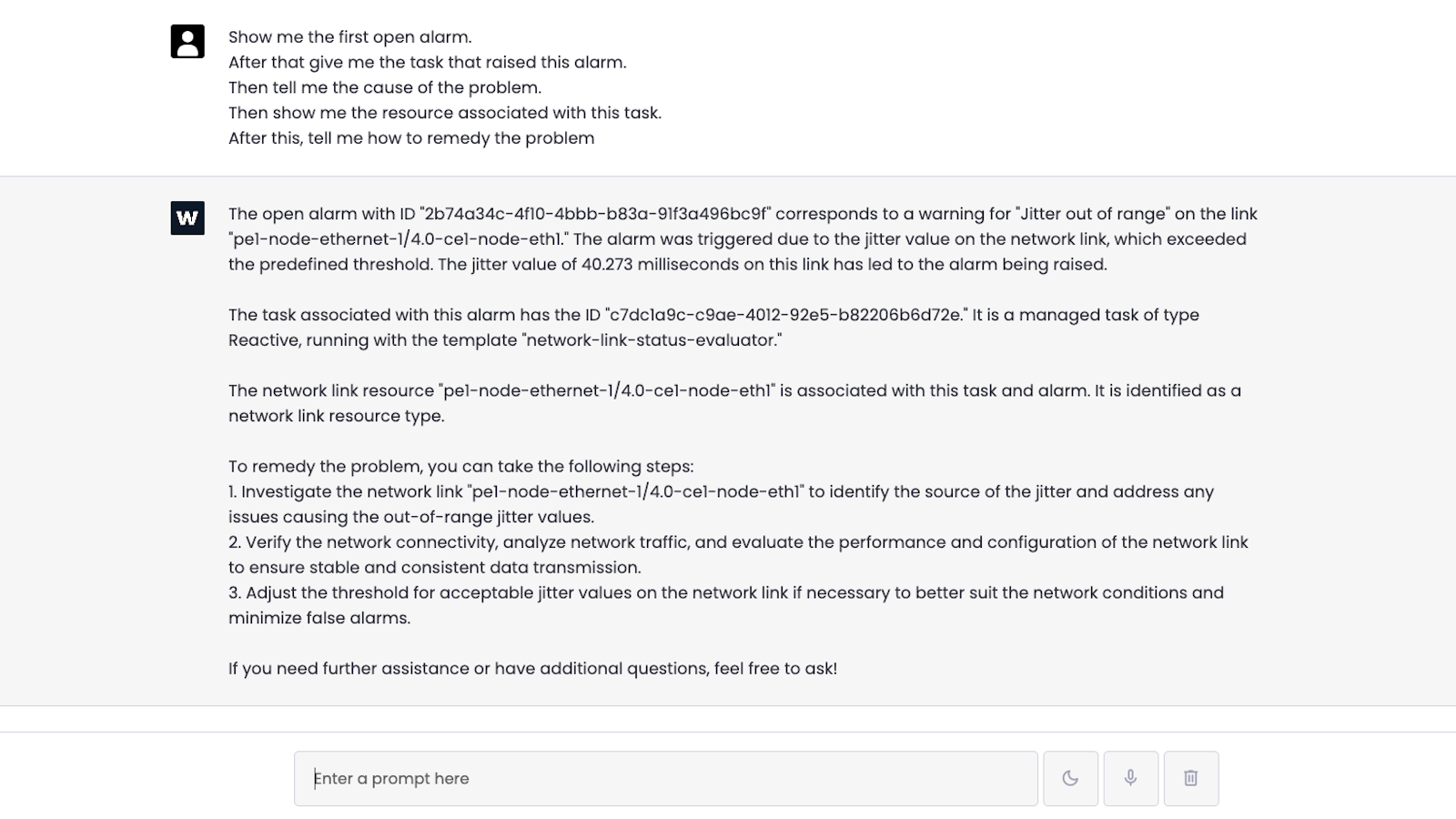Explainable auto-remedies - a fusion of causal modeling and GenAI
Billions have poured into GenAI, prompting major tech players to explore its full potential. However, its adoption in industrial settings faces significant hurdles, notably the "hallucination" issue. Leveraging GenAI for problem-solving necessitates a clear understanding of the problem at hand. Current GenAI initiatives primarily focus on tasks like knowledge modeling but often fall short in grasping problem complexities, leading to hallucinations or irrelevant outputs. Waylay pioneering approach tackles these weaknesses head-on, by integrating real time data, causal graphs and outcome insights into the training process. We combine historical records/manuals with real-time machine data to find the root cause and provide the right remedy - reducing the risk of human error, ensuring consistency that allows human workers to focus on more complex and strategic aspects of their jobs.


Industrials - the right remedy in any language
We combine historical records/manuals with real-time machine data to find the root cause and provide the right remedy in any language - reducing the risk of human error, ensuring consistency that allows human workers to focus on more complex and strategic aspects of their jobs. More about this you can find in this blog post or in this video.
Telcos - Service Assurance
Waylay platform with the synthesis of GenAI eliminates the need for extensive clicking through different tools and screens, providing a comprehensive explanation and repair actions. The reasoning process is enhanced with custom information, inventory details, object relations, manuals, and other relevant parameters. More about this you can find here.
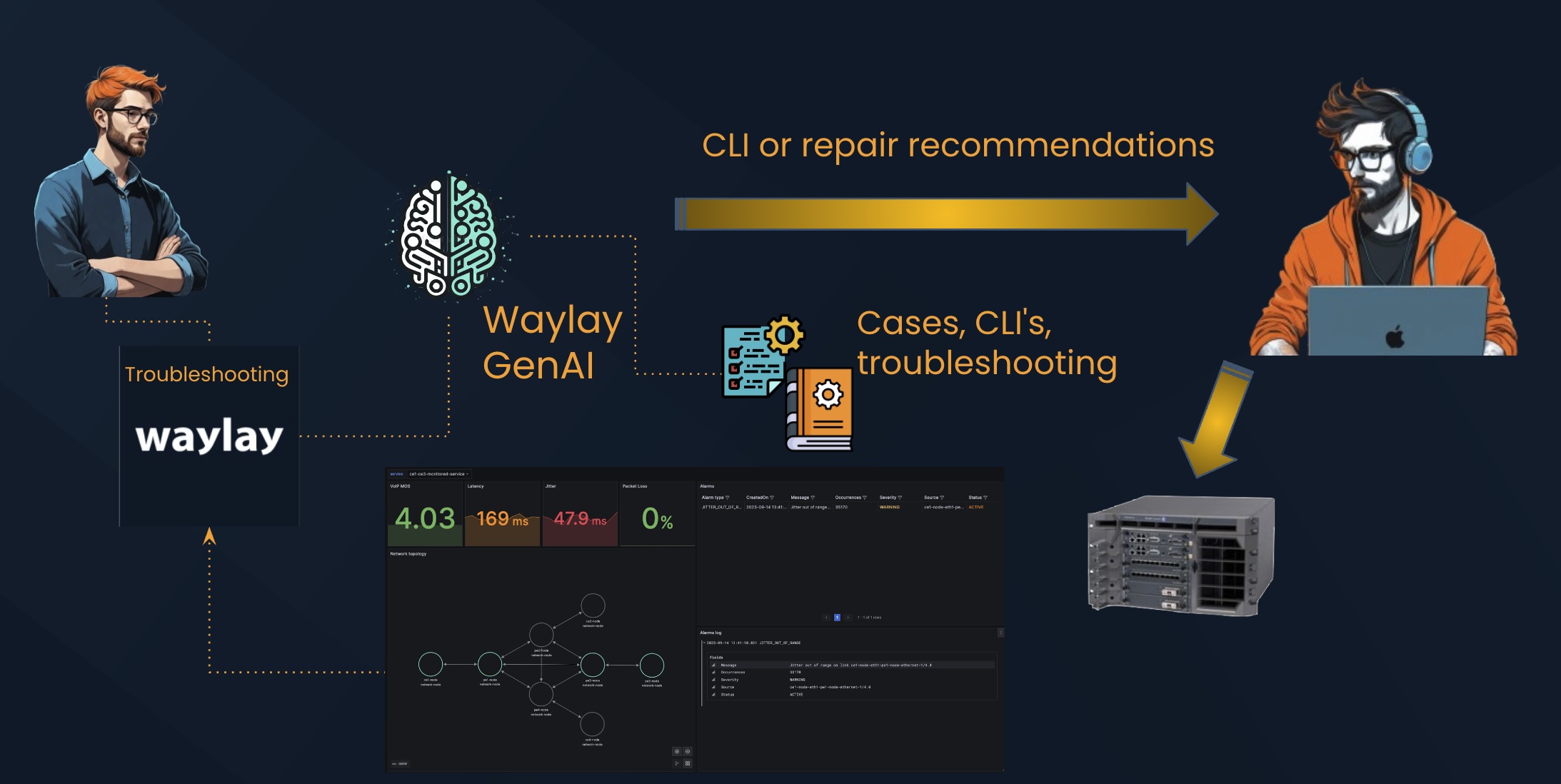
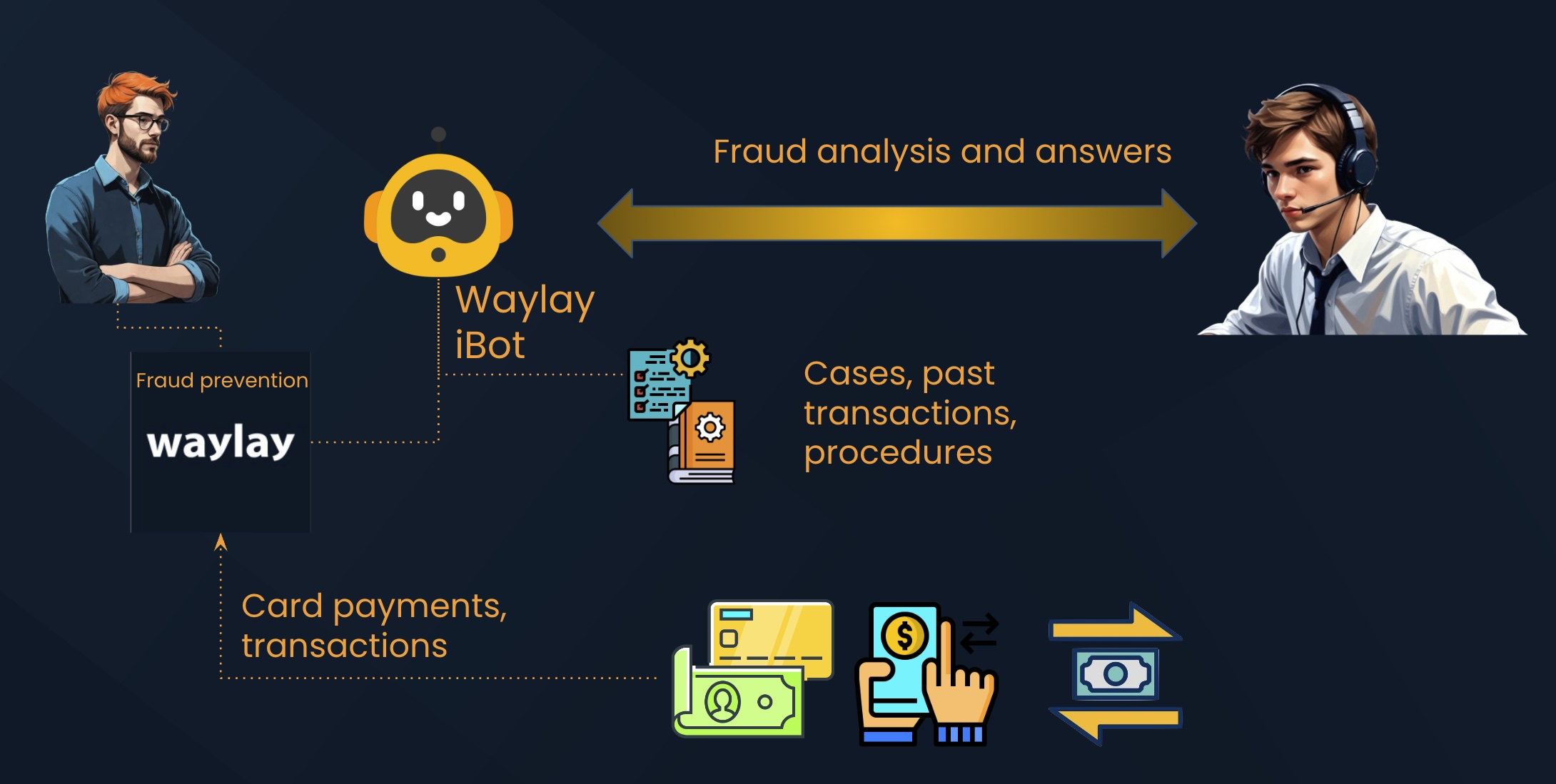
Fintech - Bots powered by GenAI: A Shift from Case Management Tools
The advent of intelligent bots is poised to reshape the landscape of financial services, prompting a reevaluation of traditional case management tools and revolutionizing the entire fraud prevention process. More about this you can find in this blog post or in this video.
GenAI Powered Network & Service Management
How about delegating audit network resources in a fraction of the time with large language models and doing automatic service reprovisiong only using GenAI powered bots? During DTW24 - Ignite, Waylay showcased the results of TM Forum Catalyst C24.0.648, pushing boundaries to build a GenAI-Powered Toolkit capable of fully automated network service provisioning and assurance based on simple, natural language intents: for more info, check out this video.
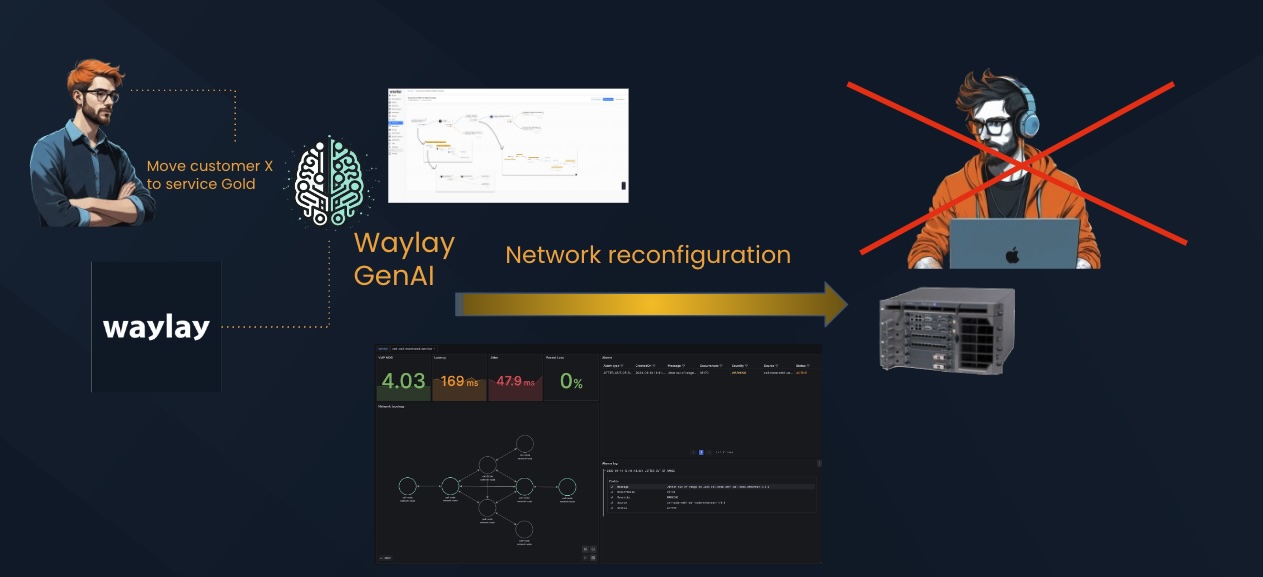
Intrigued? Let us take you back to where it all began...👇
Decoding the Future: A Decade of Automation Excellence, GenAI Breakthroughs,
and the Quest for Causality
and Explainability

Waylay Automation/Rules Engine
Over the past decade, our automation platform has undergone continuous
innovation and evolution. We have incorporated cutting-edge technologies, such as artificial intelligence
and machine learning, to enhance efficiency and drive digital transformation.
Throughout this journey,
the platform has empowered businesses across diverse industries, making automation a cornerstone of
streamlined processes and intelligent decision-making.
Now we are poised to push the boundaries even
further.
We assessed rules engine technologies across seven key capabilities
Waylay Rules Engine - Our Foundation Model
We have rigorously evaluated various prevalent types of rules engine technologies by subjecting them to comprehensive testing and scoring based on seven crucial capabilities: Modeling complex logic, Modeling time, Modeling uncertainty, Explainability, Adaptability, Operability, and Scalability. Our Rules Engine benchmarks white paper provides a detailed testing benchmark, aiding in the assessment of these core rules engine capabilities. Rules Engine benchmarks white paper.
Why is the explainability important?
- Explainable rules provide transparency into how decisions are made.
- Identifying Bias: Explainable rules can reveal biases present in the model or the data it was trained on.
- Error Detection and Correction: When LLM-generated outputs are incorrect or undesirable, explainable rules facilitate the identification of errors.
- Compliance and Regulation: In regulated industries such as finance, healthcare, and legal sectors, explainability is often a legal requirement.
- User Understanding: Explainable rules make it easier for end-users to understand how their inputs are processed and interpreted by the LLM.
- Feedback and Improvement: Interpretable rules enable users to provide feedback on the model's decisions.
GenAI and Causal Modeling
It is essential to acknowledge that existing models exhibit a degree of hallucination, and their outputs should not be solely relied upon for critical use cases. To address this, we emphasize the importance of combining these models with carefully curated Waylay training sets. These sets delineate causal relations between data and the remedies proposed by our intelligent bots, ensuring a robust and reliable solution.

Waylay Multi-Agent Studio

Building GenAI apps
With Waylay, the possibilities for building diverse GenAI applications are endless. Whether you need one-off API endpoints for root cause analysis ("rules explainer") or to request specific remedies, want to craft conversational apps with LLM-neutral bots in just a few hours, or aspire to develop complex multi-agent GenAI applications using Waylay's orchestration framework, you can do it all seamlessly.

01 | No Code Waylay Agent Studio
In under an hour , you can construct a single-entry API endpoint capable of unleashing the full potential of GenAI in conjunction with any third-party API endpoint, seamlessly integrating it into your application. Additionally, you can design an intuitive interface offering multiple choices, all while retaining complete control over the responses, which are subsequently directed to various LLM endpoints—whether with or without RAG — allowing for management of the generated responses. This streamlined process mirrors the architecture behind the Waylay Rules Explainer.

02 | Conversational Apps and Bots
Easily integrate any third-party APIs into your conversational bot with just a single click. Unlike traditional conversational bot development, often taking weeks or even months, the ability to swiftly create LLM-neutral bots enables organizations to deploy solutions rapidly. This agility allows businesses to address immediate needs and respond promptly to evolving market demands, staying ahead of the curve in today's fast-paced digital landscape.
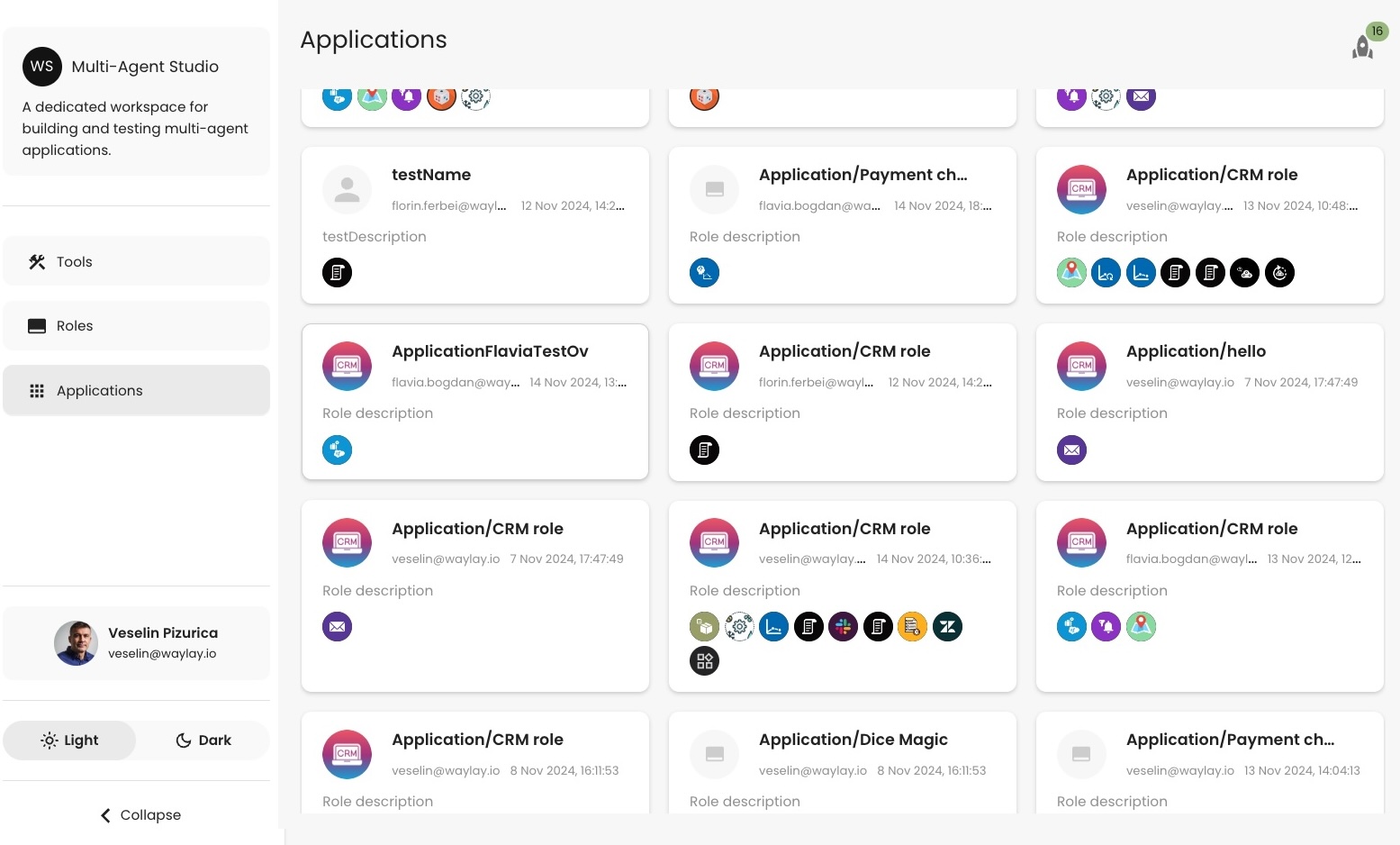
03 | Building mult-agent GenAI apps
Building multi-agent GAI applications involves creating systems that can perform tasks across various domains and interact with their environment and each other autonomously. These applications have the potential to revolutionize various industries by enabling intelligent systems to work together autonomously to achieve complex goals. With Waylay, you can orchestrate different GAI agents and deploy new apps in few hours. Check out the video.
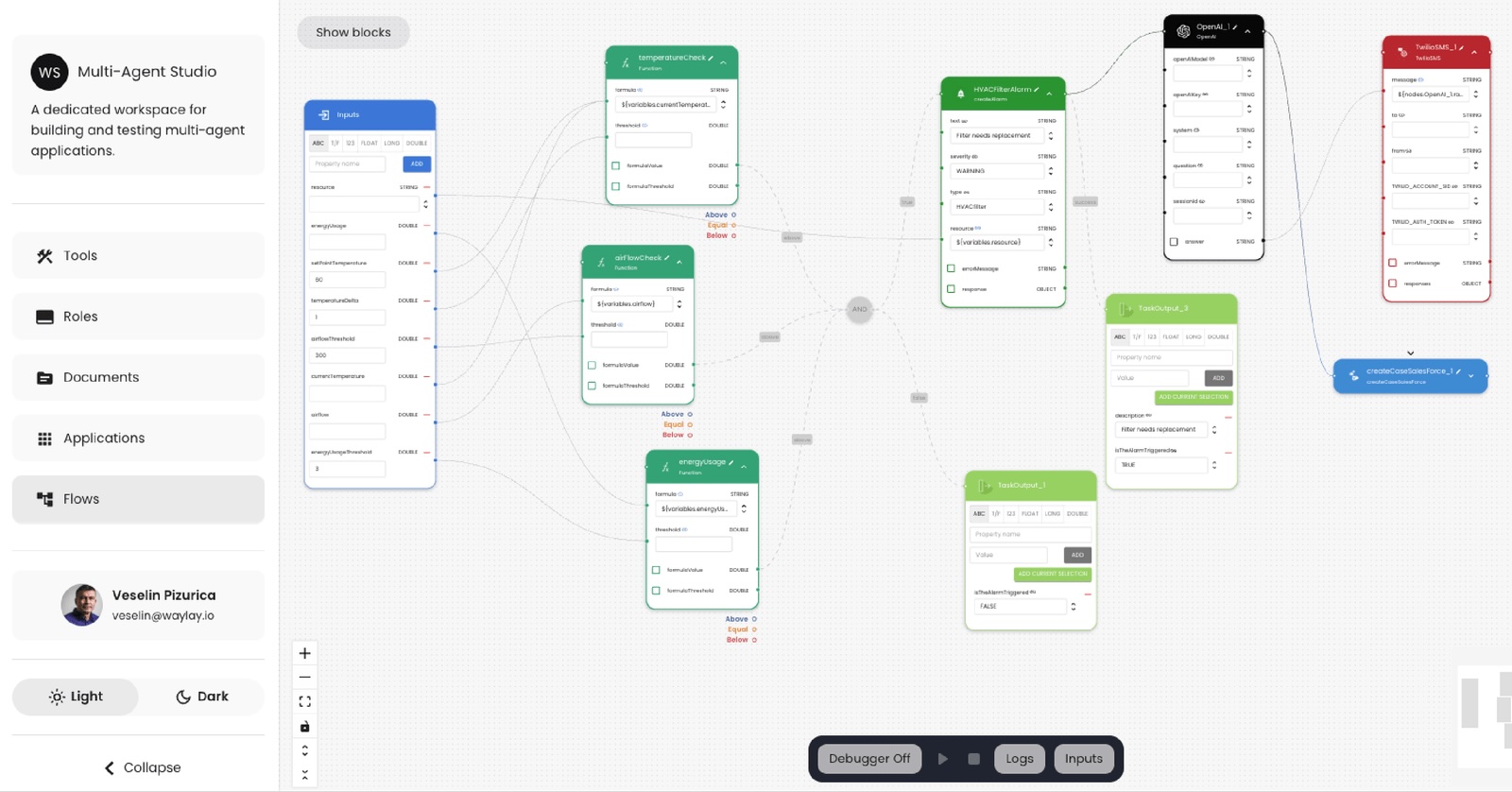
04 | Building Flows and Rules
The same APIs and external connectors power RPA flows, rules and agent-based tools/actions in assisted bot use cases. This is possible because the Waylay plugin interface and rule templates are designed from the ground up with detailed function descriptors, including precise input and output arguments.
Towards Building Natural Automation Interface (NAI)

Intelligent Bots (iBots)
Waylay introduces a groundbreaking approach to deploying Intelligent Bots
(iBots), setting them apart by their independence from a singular foundational model and the absence of
reliance on specific customer data. These iBots underwent training using test results from automation
graphs, guided by a 'highest probability' rationale for outcome detection.
This innovative methodology
forms the foundation of our training set, drawing efficacy from its exceptional explainability and logical
model abstractions inherent in the Waylay Rules Engine.

01 | Unleashing the Potential of Generative Artificial Intelligence (GenAI)
In the ever-evolving landscape of technology, the integration of artificial intelligence (AI) and machine learning (ML) has significantly transformed various industries. Now, a new frontier emerges as Generative Artificial Intelligence (GenAI) steps into the spotlight, accompanied by Natural Language Processing (NLP) bots.
This dynamic duo is poised to redefine automation across diverse sectors.

02 | Moving from Low-code Automation to
AI-driven Automation
Within Waylay, developers can craft concise code snippets or leverage
existing ones, linking them through logical operators to define intricate automation rules. By
interconnecting these rules or embedding one within another, Waylay can facilitate the creation of
highly complex automation scenarios.
Now, imagine interacting seamlessly with the automation engine using natural voice or text
commands.

03 | Streamlining Human-Guided Solutions with Auditable Precision
Waylay’s rules engine is built on top of causal DAG, where a BN network is abstracted at the level to which humans tend to think about automation problems. This feature enables automation logic to be explainable to humans in a simple and intuitive way. This concept enables the execution of automation scenarios using human language, with built-in auditability for human comprehension during operation.

04 | Natural Automation Interface (NAI),
an interface capable of
bidirectional communication.
An interface capable of bidirectional communication is the essence of what we refer to as a Natural Automation Interface (NAI), an interface capable of bidirectional communication. It can be programmed to execute specific automation scenarios using human language and, crucially, allows for the program's audibility by humans once it's in operation. More about this you can find in this video.

Where we go from here?
Get ready for an exciting journey into the future as we unveil a sneak peek into the innovative ventures and groundbreaking initiatives planned for the coming year. We're thrilled to share with you the new and cool developments that will redefine the way we operate and engage. From cutting-edge technologies to transformative strategies, join us on this forward-looking adventure as we shape a year filled with excitement, innovation, and remarkable achievements. Buckle up for a thrilling ride into the future of what's next! 👇
Videos
Automated Remedies for Connected Assets in Salesforce
Digital Twin acts on the unseen rules through innate causal inference modeling. In a demonstration featuring a connected electric bus, the system identifies issues like battery degradation through diagnostic trouble codes and CAN values, prompting proactive alarms. A Rulea Explainer is integrated within Salesforce, providing service agents with detailed explanations and remedies for proactive alarms generated by the system.
Waylay Digital Twin powered by GenAI for ServiceNow
If you’re a Service Agent whose task it is to work on predictive and preventive asset health notifications, your job is to determine as efficiently as possible what should be done to resolve the issue and prevent asset downtime. This often involves a decision to create a case, support ticket, a work order, escalate the problem to a different team, etc. Waylay DT Explainer assistant is going to help create that technical assessment.
Integrating Waylay with Einstein Prompt Builder
At Waylay, we've created a small demo of Einstein for IoT preventive maintenance. We're using Flex Prompt Templates, template-triggered prompt flows and LLM model orchestration.
Fintech - Bots powered GenAI
A Shift from Case Management Tools The advent of intelligent bots is poised to reshape the landscape of financial services, prompting a reevaluation of traditional case management tools and revolutionizing the entire fraud prevention process.
GenAI Powered Network & Service Management
During DTW24 - Ignite, Waylay showcased the results of TM Forum Catalyst C24.0.648, pushing boundaries to build a GenAI-Powered Toolkit capable of fully automated network service provisioning and assurance based on simple, natural language intents.
GenAI: Closed Loop Automation
Incoming messages contain site information and telemetry metrics such as latency, jitter, and bandwidth usage. The SLA workflow is straightforward: it collects site telemetry data over a specified time window and counts the number of threshold crossings within this period, based on reference thresholds from the site properties. If the number of crossings exceeds a predefined value, an alarm is raised, and the configured remedy workflow is automatically initiated.
Interactive Service Provisioning
Panamax Interactive Bot implemented on top of Waylay GenAI, for which Waylay with its partners won Outstanding Catalyst Award - Use Of TM Forum Assets, that is awarded to the team that shows the most powerful use of TM Forum assets in their Catalyst project and quantify the benefits of using these assets.
Building Natural Automation Interface (NAI) in Action!
In the initial phase of converting text to rules, Waylay systems utilizes advanced (NLP) capabilities to extract nuanced meaning from textual instructions. As we comprehend the context, we accurately translate human intent into a set of logical rules. In the reverse process, when moving from rule definition to human explanation, Waylay generates natural language explanations that explaines the logic embedded in the rules.
Create new chat bots in matter of minutes!
Easily integrate any third-party APIs into your conversational bot with just a single click. Unlike traditional conversational bot development, often taking weeks or even months, the ability to swiftly create LLM-neutral bots enables organizations to deploy solutions rapidly. This agility allows businesses to address immediate needs and respond promptly to evolving market demands, staying ahead of the curve in today's fast-paced digital landscape.
Evaluating the Role of Large Language Models (LLM) in API Orchestration and Decision-Making
Is Using an LLM as the Reasoning Engine a Good Idea? What is a multi-agent concept? How does Waylay utilize subflows to manage what an LLM can and cannot do from a control perspective? In this video, we explore these questions in depth.
Blogs
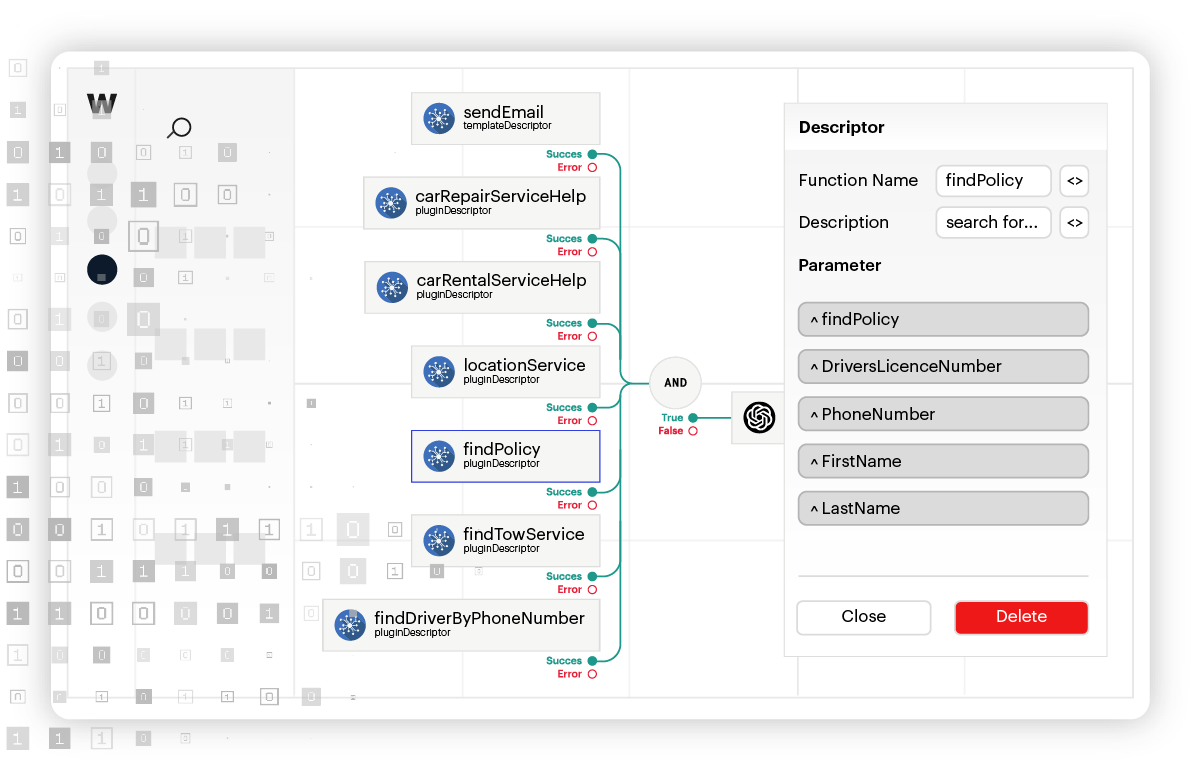
"The Next-Gen(AI) RPA" - The multi-agent concept in Waylay
In this blog post, we discuss the use of LLM for orchestrating agents in a manner similar to robotic process automation (RPA) but with enhanced flexibility and intelligence. In Waylay we transform any API endpoints into LLM Agents in no time! Furthermore, we can combine multiple APIs into a cohesive workflow and expose it as a "super agent function."
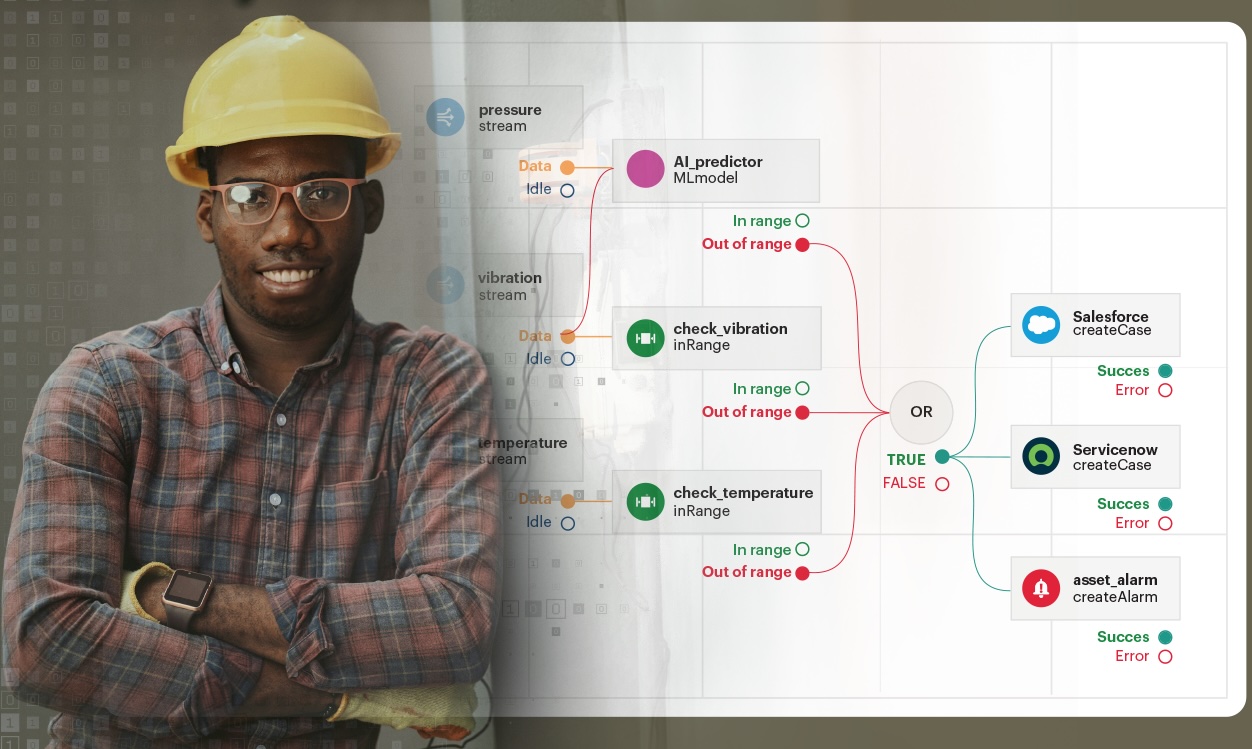
GenAI Falls Short in Predictions and Troubleshooting, but Shines When Combined with Waylay Tech
Waylay is not solving the GenAI hallucination problem, nor is trying to improve existing LLM reasoning architecture. Rather we are in a smart way combining the power of causal modeling (which is explainable) with power of LLM to interpret these models correctly, and then to mix it with awesome power of GenAI in the context of knowledge summaries and search - which is our context used for finding the right repair manuals. More about this you can find in this blog post.

Waylay GenAI for Field Service Operations Generates 120% ROI in the first Month in Production and 267% every month thereafter
In this blog post, we discuss the ROI for implementing Waylay DT and GenAI that shows a significant improvement over the traditional approach, with potential returns exceeding 120% in the first month and 266.7% in subsequent months. This highlights the efficiency and cost-effectiveness of the new system in handling CRM tickets.

Improving Customer Experience through Multi-Language Support and Efficient Repair Instructions
Waylay Digital Twin efficiently retrieves relevant solutions from different documents, improving accuracy even when specific manuals are lacking detailed instructions. Additionally, we integrated real-time language translation to provide precise repair instructions globally, ensuring technicians receive accurate guidance regardless of location. More about this you can find in this blog post.
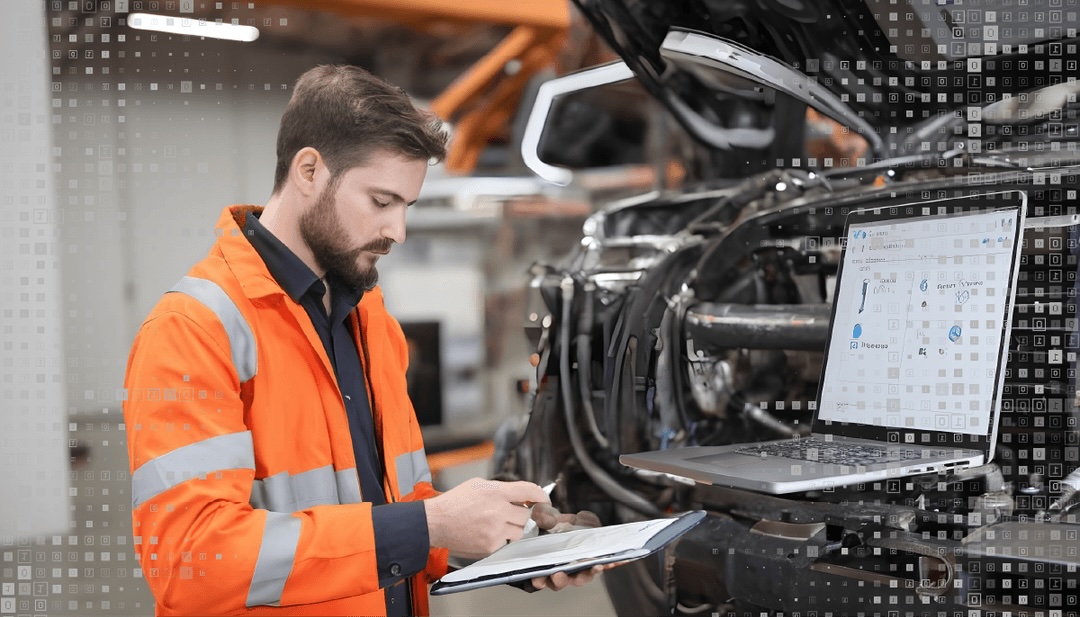
Predictive Maintenance and Generative AI
In this blog post , we'll explore the impact that Generative AI can have on the productivity of service operations in industrial and manufacturing enterprises. And why Waylay is ideally suited to harness the power of large language models in combination with predictive and preventive maintenance asset monitoring rules.
You will also learn how we’ve extended the Waylay Digital Twin application for Salesforce Service Cloud with the Rule Explainer assistant.

Explainable GenAI for NOC service assurance
Complex topologies can generate an avalanche of events that require equally complex correlations, taking its toll on incident analysis and resolution times.
The novel approach that blends the explainability features of the Waylay platform with the GenAI eliminating the need for extensive clicking through different tools and screens, providing a comprehensive explanation in a streamlined manner.

The Transformative Impact of Intelligent Bots in Troubleshooting
In the ever-evolving landscape of technology, the integration AI and ML has significantly transformed various industries. One area where this transformation is particularly noticeable is in the realm of troubleshooting and technical support. Traditionally, case management tools have been the go-to solution for handling these issues, but a new wave of intelligent bots, armed with machine manuals and real-time machine data, it is poised to revolutionize the troubleshooting process.

New Case Management Tools powered by GenAI
In the ever-evolving landscape of technology, the integration of artificial intelligence (AI) and machine learning (ML) has significantly transformed various industries. One area where this transformation is particularly noticeable is in the realm of fraud prevention. Traditionally, case management tools have been the go-to solution for handling these issues, but a new wave of intelligent bots is poised to revolutionize the use case management process.
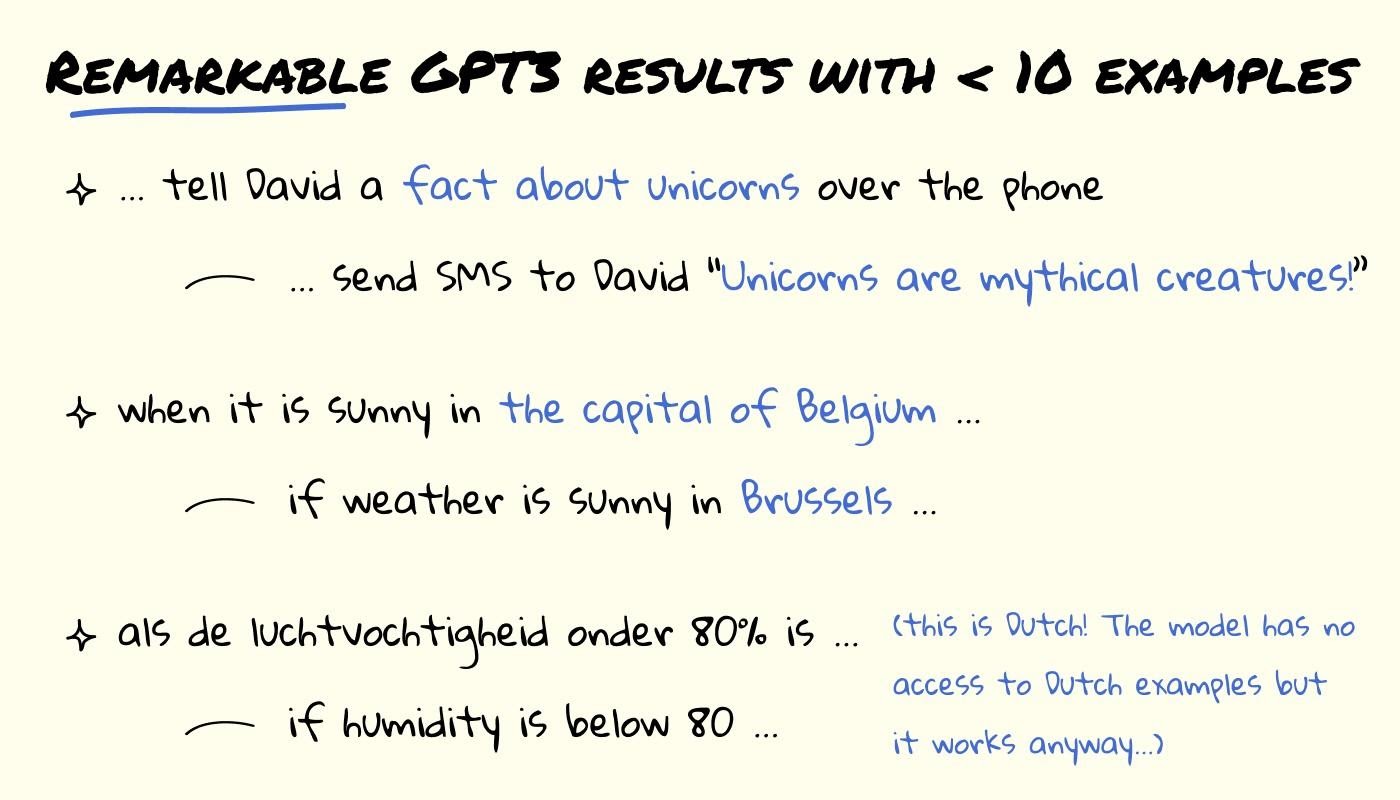
Almost no data and no time? Unlock the true potential of GPT!
In this blog post , we will explore how the advent of large pre-trained language models are giving rise to the new paradigm of 'prompt engineering' in the field of NLP. This new paradigm allows us to rapidly prototype complex NLP applications with little to no effort and based on very small amounts of data.

Solving the weak spot of current GenAI solutions
Billions of dollars have flooded into GenAI, attracting major tech players to look into its potential beyond mere trivia such as image/video processing and knowledge summaries. Yet, its integration into industrial settings encounters notable hurdles, particularly the "hallucination" issue. Utilizing GenAI for problem-solving demands a profound understanding of the specific issue at hand. More about this you can find in this blog post.

When Increasing GenAI Model Temperature Helps: Beneficial 'Hallucinations'
It might sound surprising, but sometimes a bit of 'hallucination' is just what we need. In industrial applications, leveraging these creative outputs can uncover solutions that aren't immediately obvious, enhancing the troubleshooting process and driving innovative problem-solving.
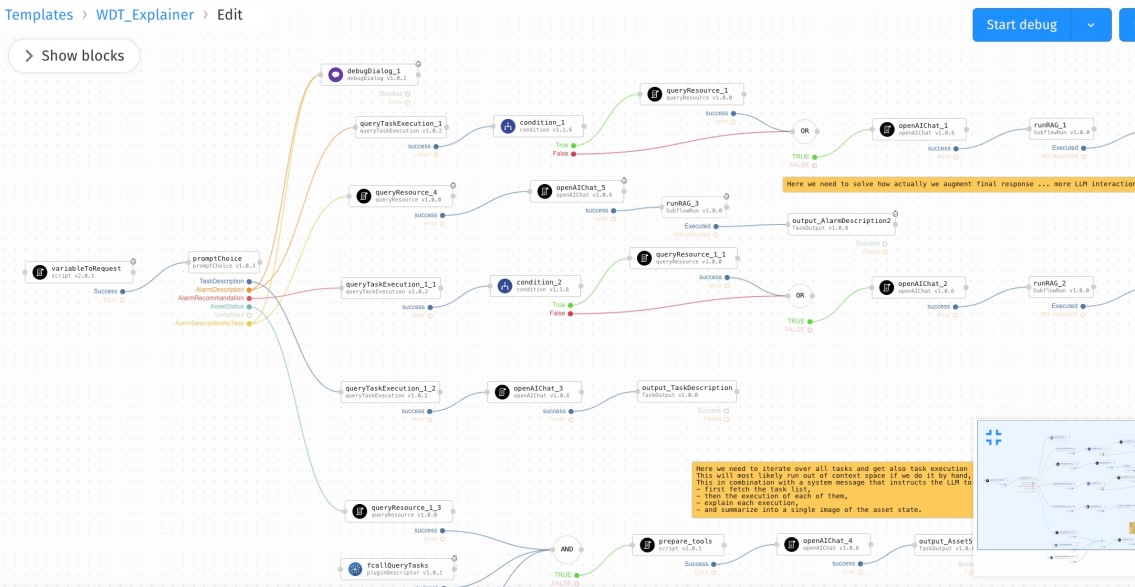
White paper on Waylay GenAI automation
We explore two distinct approaches to leveraging GenAI within the context of Waylay. The first allows us to design and explain the actions taken by the algorithm, providing a clear understanding of its behavior using GenAI. In the second approach the large language model (LLM) takes the reins to create a complete end-to-end automation scenario based on its reasoning, introducing a new level of autonomy and complexity. More about this you can find in this article.

Evaluating the Role of Large Language Models (LLM) in API Orchestration and Decision-Making
In this blog post, we discuss whether using an LLM as the Reasoning Engine a Good Idea? What is a multi-agent concept? How does Waylay utilize subflows to manage what an LLM can and cannot do from a control perspective? In this blog, we explore these questions in depth.


